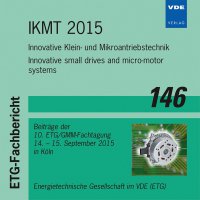Improvement of the operating behavior of small induction motors by finding an optimal rotor skewing angle and a harmonic distribution of the number of turns
Konferenz: IKMT 2015 - 10. ETG/GMM-Fachtagung Innovative Klein- und Mikroantriebstechnik
14.09.2015 - 15.09.2015 in Köln, Deutschland
Tagungsband: IKMT 2015
Seiten: 7Sprache: EnglischTyp: PDF
Persönliche VDE-Mitglieder erhalten auf diesen Artikel 10% Rabatt
Autoren:
Strbac, Dejan; Gottkehaskamp, Raimund (Department of Electrical Machines and Electromagnetic Field Theory, University of Applied Sciences Düsseldorf, Düsseldorf, Germany)
Inhalt:
For the motor optimization and calculation an analytical model is used and presented. The model describes the steadystate operation behavior of small induction motors with squirrel cage rotor, including its parasitic effects. An asymmetrical current and phase system is assumed. Furthermore, it is possible to define a harmonic distributed winding. The multiple armature reaction and all occurring harmonics, except saturation harmonics, are taken into account accurately. The magnetomotive force (MMF) of the air-gap is generated by thread-like surface currents, placed on the surfaces of the stator and rotor. This induces a radial, one dimensional air-gap field. As a result of the stator and rotor slot openings of a real induction machine, the air-gap modulation is taken into account via magnetic permeance waves. The product of the MMF and the permeance waves results in the modulated magnetic flux density waves. A virtual displacement method without constraints is used to calculate the torque of the motor. It allows the calculation of the asynchronous torque as well as all occurring parasitic torque components. In this paper attention is paid to the synchronous torque components. The skewing of the rotor is most important for the start-up of an induction machine. Since the skewing also negatively affected the performance of the machine, the skewing angle should not be bigger than necessary. With the presented model it is possible to calculate the optimal rotor skewing angle. Furthermore, it is possible to improve the operating behavior marginal by a harmonic distribution of the number of turns within a coil group. The influence of a harmonic winding distribution on the harmonic behavior is presented by an example. Some proposals concerning the winding design and the harmonic distribution are made. This analytical model is valid for small three phase induction motors in δ and star connection, Steinmetzconnections and two-phase induction motors (capacitor motor). The validation is achieved by comparing it to measurements.


